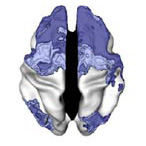A new paper by Prather et al. identifies song-specific neurons in the swamp sparrow that are active during song perception and song performance. These properties suggest that the neurons might be part of mirroring system analagous to those identified in primates. As far as I can tell, this is the first paper on mirror neurons that Nature has published, though its sibling journals have been kinder to the emerging field (see here and here; note the infamous Iacaboni is an author on both). Because mirror neurons have received extraordinary media attention, sometimes it’s hard to separate the facts from the hype. This Nature paper lends credibility to the field by establishing a small-animal model for future investigation.
Prather et al. measured action potential activity using motorized microdrives that precisely positioned electrodes in the telencephalic nucleus HVC, a brain region known to be involved in singing and song perception. They found that the pattern activity in these regions was nearly identical for auditory perception and song vocalization (see figure below). The authors do note one difference between the neural correlates of action and perception: HVC neurons fired single action potentials during song perception but fired in bursts during song vocalization.

The authors also prove that activity during song vocalization cannot be explained in terms of auditory feedback. For instance, the authors show that HCV activity is not influenced by auditory distractions while a bird is singing. This suggests that activity during singing reflects a corollary discharge from motor systems.
I think the most exciting aspect of this research is the translational potential. Now that we have a small-animal model, it will be easier to test the effects of genetic and pharmacological manipulations on mirror neuron systems. Further research might provide important insights about language acquisition and how it is disrupted in certain pathologies (i.e. autism).

 Zachary Tong at Distributed Neuron
Zachary Tong at Distributed Neuron  Jake Young at Pure Pedantry
Jake Young at Pure Pedantry  Ed Yong at Not Exactly Rocket Science
Ed Yong at Not Exactly Rocket Science 
 In case you haven’t heard, Harvard psychology professor Steven Pinker is touring the country in a thinly veiled campaign to sell his new book,
In case you haven’t heard, Harvard psychology professor Steven Pinker is touring the country in a thinly veiled campaign to sell his new book,